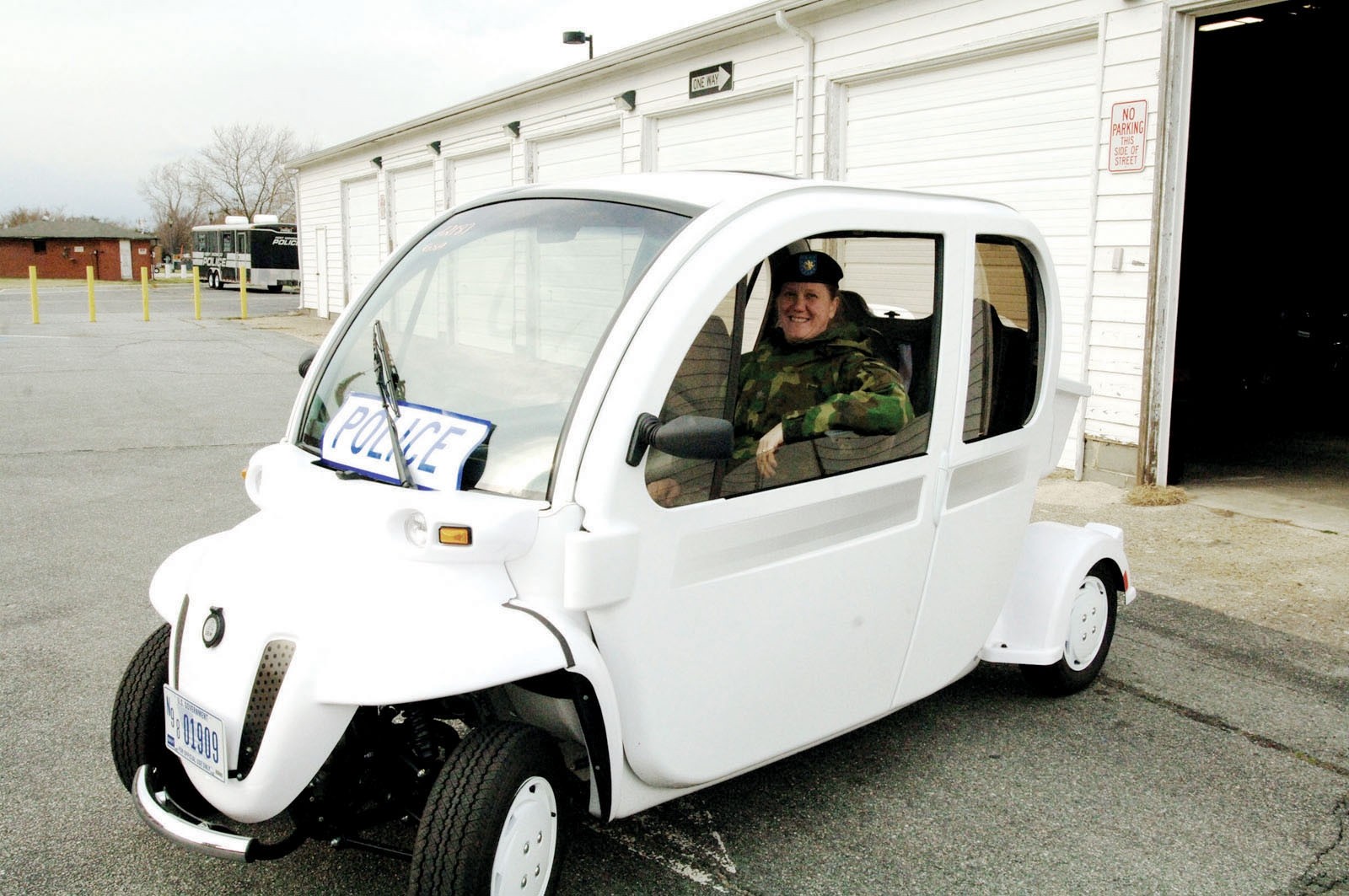
FORT MONROE, Va. (Army News Service, Feb. 6, 2007) - It may not be equipped for high-speed chases or hauling in bad guys, but the new Provost Marshal Office vehicle that arrived here in late January includes one key feature that's quite remarkable.
No matter how far it travels, it won't use a single drop of gas.
With seating for up to four people, a maximum speed of 25 mph and a range of 35 miles on a full charge, the Neighborhood Electric Vehicle - or NEV - is "pretty much perfect" for everyday administrative transportation requirements on post, according to Maj. Heidi Kavanaugh, Fort Monroe provost marshal.
The white, bubble-shaped buggy is completely street legal - meaning it's equipped with windshield wipers, rearview mirrors, headlights, taillights, seat belts, a parking brake and other features. The battery that makes the NEV go can be recharged from any standard 110-volt outlet.
"We're renting the vehicle from the Navy for about $180 a month," Kavanaugh explained. "We don't pay anything for maintenance, which is minimal from what I understand, and they'll replace it if anything does malfunction."
All of that is seriously good news to an organization that has been paying as much as $3,000 annually for the upkeep of each one of its gas-powered "mules" - those red, two-seat carts that are often seen darting around post. Rust is one of the biggest problems, Kavanaugh noted. They also require a lot of engine work.
"One of our mules died recently, so we were in the market for a replacement vehicle," she explained. "Several months back, Col. (Jason T.) Evans challenged the garrison directors to find new ways to support the environmental program. That was in the back of my mind when we (the PMO leadership) heard about the NEVs. So we decided to take a look to see if one of those would fit our purposes. Obviously, it did and here we are today."
What the NEV represents is as important as its ability to save energy and reduce harmful exhaust emissions, noted Peter Van Dyke from the Fort Monroe Environmental Office.
"It's a good example of what happens when you think a little bit outside the box," he continued. "PMO could have easily purchased another gas-consuming vehicle and carried on with business as usual. Instead, they took a little time to explore alternatives that were more environmentally friendly. And we all win because of the cost savings in the areas of maintenance and fuel consumption; and it sets a precedent for other organizations that may want to go the same route.
"It's also great to see that organizations and tenants on post are being good environmental stewards without any arm twisting from the environmental division," Van Dyke said. "This is at the heart of what we've been trying to accomplish here with our education efforts and environmental management system."
Kavanaugh said she's excited about the community's response to the NEV - numerous employees have flagged her down and asked for a ride. And she said she would be "more than happy" to put other agencies on the installation in touch with the folks who provided the NEV.
"I think you're going to see at least a few more of these cars on post in the near future," she added. "Given the size of the installation and its limited parking, it really is a great solution. And it's another way to demonstrate our determination to save Army money and protect the environment at the same time."
While motorists may not see actual NEV's out on the open road anytime soon - they're too slow for most highways and many city ordinances limit their use to 35-mph-zones - the concept itself is certainly a sign of things to come. Following his State of the Union address last week, President Bush signed an executive order mandating that all federal agencies with more than 20 vehicles use "plug-in hybrid electric vehicles," or PHEVs, as soon as they become commercially available.
GM introduced the plug-in prototype Chevrolet Volt at the 2007 North American International Auto Show in Detroit earlier this month. Ford, in conjunction with the Energy Department, has spent about $100 million on its fleet of 11 PHEV prototypes, to include the Edge HySeries. More than 20 Dodge Sprinter PHEVs will be placed in the U.S. between now and early 2008 as part of a test fleet program, according to a DaimlerChrysler press release.
The cost of powering a PHEV is 2 to 4 cents a mile, compared with 8 to 20 cents per mile (depending on fuel efficiency) for a conventional gasoline-powered car, according to a recent Union Tribune news article found on the Internet. Plug-in prototypes typically go 20 to 30 miles on battery power alone, with zero emissions, the article also said.
Since the average American commutes less than 30 miles per day, many PHEV owners would rarely have to use gas, except to go on trips. It's also estimated that a typical PHEV sedan would get 100 miles or more per gallon of gas, on average, when longer trips are factored in.
(Patrick Buffett writes for the Fort Monroe "Casemate.)

Social Sharing